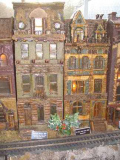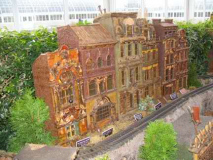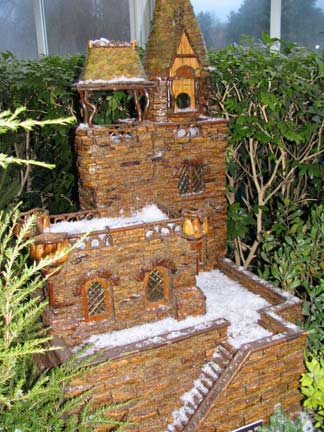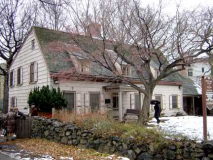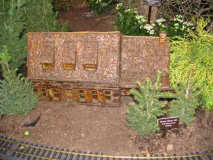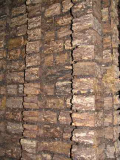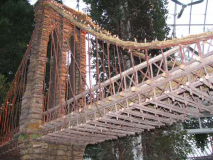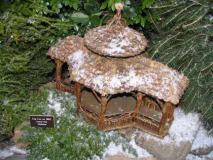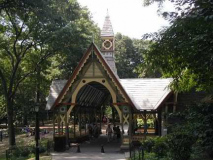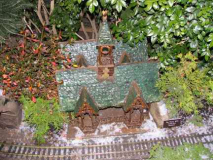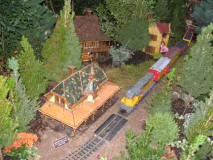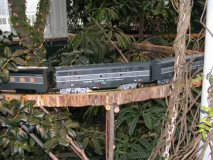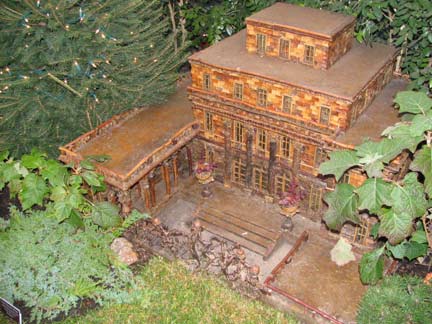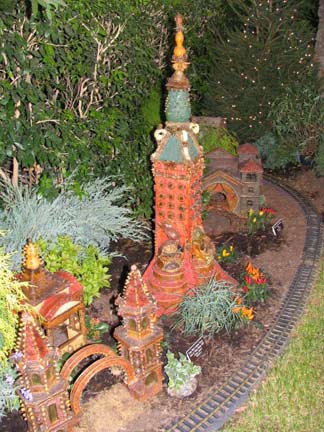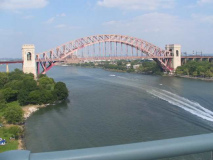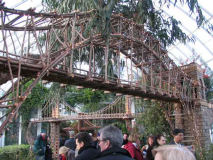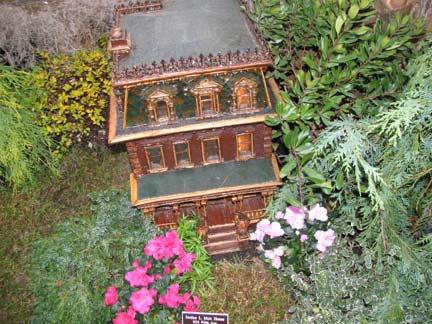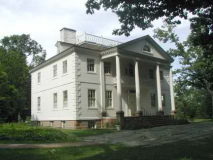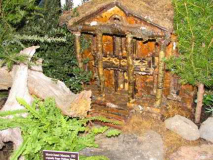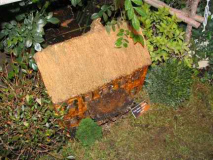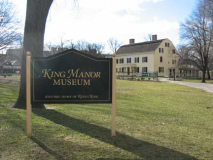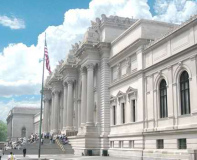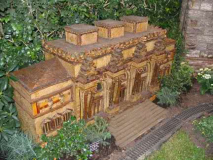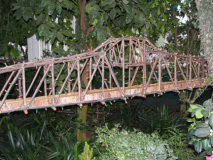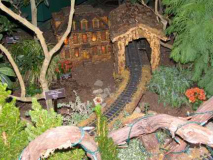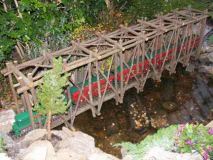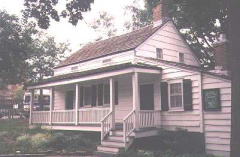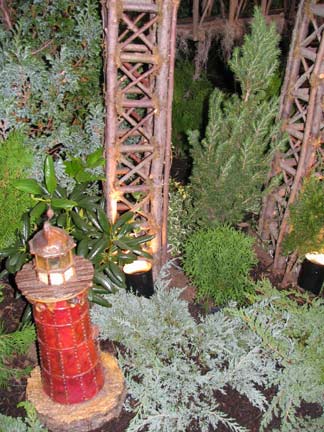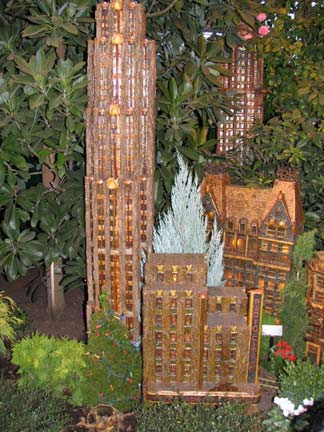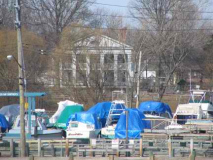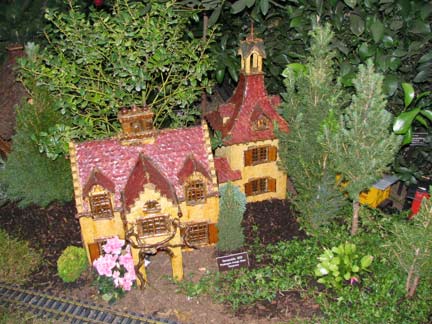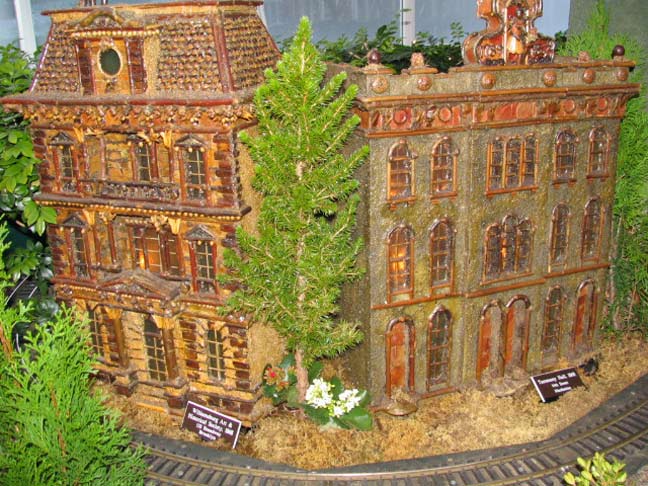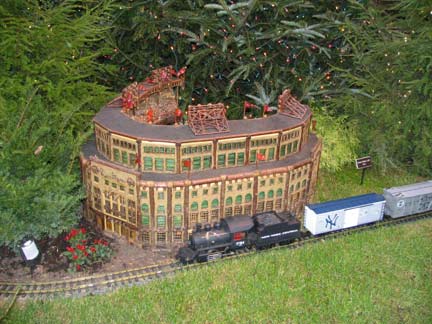From the ForgottenBook: The New York Botanical Garden and New York Zoological Park (known to all as the Bronx Zoo) are the two main divisions of Bronx Park, which was acquired by the city (mostly from the Lorillard estate in the center of the Bronx) in late 1888 and early 1889. By 1891, the city had allocated fully 250 acres to be used as a botanical garden… which has developed into one of the world’s premier gardens, with visitors drawn year-round to its collection of temperate and tropical plants and perennials, with many acres of groves and forests. The Bronx River, which is generally a grimy, industrial flow of sludge south of the park, is here magically transformed back into the pristine fresh water brook it was before the Bronx was settled and even enjoys some swiftly rushing waterfalls here. A hemlock forest deep in the Botanical Gardens is left over from the pre-colonial era, and the Lorillard snuff mill (the family was and is one of the world’s chief tobacco processors) can still be found deep within the park.
Every Christmas, there’s an incredible model train show that incorporates dozens of famous (and not as famous) NYC architectural highlights, constructed from twigs, leaves, bark, berries and other natural materials by Paul Busse and his team at Applied Imagination at Alexandria, Kentucky; most of the materials that go into the models come from the surrounding forest in Kentucky! The show has been going on at NYBG since the early 1990s. I’ve seen it two of the last four years, and though it’s got competition from model trains at the Transit Museum at Grand Central Terminal (which is modest, since that space is rather small) and the Citicorp Tower (truly impressive — it shows a small town in four seasons) the NYBG train show takes the title as the greatest model train show I’ve ever seen in NYC. The reason is because Busse and his team accent the set with NYC and Westchester County buildings that range from the tried and true landmarks to buildings only NYC history buffs would know.
My history with model trains has heretofore gone unmentioned in FNY, but as a kid I had several. We had a big aluminum foldout dining table we used for guests, and my father and I unfolded it and set up the trains, which went in a circle around a small town I constructed in my bedroom. I loved adding details like plastic trees, houses and even streetlights purchased from Walt’s Hobby Shop, which had two stores in Bay Ridge in the late 60s and early 70s. We used N scale (the smallest available, I believe) marketed under the title Postage Stamp Trains; I forget the make. There were two problems though. We could never get an adequate cover for the set when we weren’t using them, and as a result, dust would be a problem; and my father would insist on storing them in our apartment house basement, where of course they would get stolen. I’m sorry I never pursued the hobby past high school. Every year we’d attend an extensive model trains show put on by some mavens in a basement on Oliver Street near Shore Road in Bay Ridge. If anyone remembers it, let me know.
ForgottenFan Al Kato: Postage Stamp trains were made by Aurora. N scale has grown by leaps and bounds in the meantime, with many great-running engines, much more realistic overall, though sometimes more expensive than you might expect. You might want to check out current goings-on, but perhaps avoid old Red Caboose on Manhattan’s West Side, home of the crankiest train dealer east of the Mississippi.
Also, smaller yet is Z scale (1:220). It began in 1972 but we would probably have never known about it here at the time, and starting out as only European-style cars and locos made it less interesting in the US at the time.
From the NYBG Train Show brochure:Some of the structures are familiar landmarks; others are less well known or no longer standing. Working from photographs, Paul Busse and his crew create easily recognizable, small-scale translations rather than precise replicas. Just as a skilled caricaturist captures a personality with a few strokes of a pen, they capture the essential, distinguishing elements of a building with plant materials.
Shown above are a set of 5th Avenue and midtown townhouses that have since vanished. The title card, at the top of the page, shows the Busse [pronounced “Bussey” by the way] team’s rendering of the George Washington Bridge, engineered in 1931 by NYC’s eminent bridge buildier of the 20th Century, Othmar Ammann. The GWB is a new addition to the Train Show in 2007. That bridge was originally going to have a stone or brick cladding, but the Depression forced the builders to cut corners. I’m glad the stone was left off.
Apollo Theater. Located on West 125th between Adam Clayton Powell Jr. Blvd. (7th Avenue) and Frederick Douglass Blvd. (8th Avenue), the Apollo opened as the New Burlesque Theater in 1914 and became the Apollo in 1934 — reversing its whites-only policy in the process. It’s been the center of Harlem’s cultural and entertainment milieu ever since.
Belvedere Castle, Central Park. Built in 1869 from Manhattan schist rock at Central Park’s highest natural point, it is the site where NYC’s meteorological readings are taken.
To begin construction, the buildings are “blocked out” from a waterproof, foamcore-like base. The stone facades are simulated with various grades of sand, blue, and tile grout. Natural materials are then added bit by bit with hot glue. All of the “glass”, which so delicately fills the frames of the many twig-framed window sills, is poured from casting resin. Finally, the buildings are coated with polyurethane to make them weather and water resistant.
Bowne House, Bowne Street, Flushing, Queens. This quaint one-story house on Bowne Street north of 38th Avenue was built about 1661 by English settler John Bowne. Peter Stuyvesant, prosecuting a campaign against religious dissenters, had Bowne, a Quaker ally (accounts differ on whether he himself was one), arrested in 1662. He was subsequently exiled to Holland; while he was there, the Dutch West India Company reversed Stuyvesant’s intolerant policy, and Bowne returned home to this house in Flushing in 1664.
Brooklyn Bridge. The first major bridge to span the East River was built between 1870 and 1883 and was designed by John Roebling, who died during construction after suffering a severe injury and contracting tetanus. His son Washington took over for him but contracted caisson disease after working in the compressed air under the East River; he directed construction from his home in Brooklyn Heights, with his wife Emily relaying his instructions to the on-site builders after getting up to speed in engineering.
The Brooklyn Bridge remains NYC’s only major stone-clad bridge and only suspension bridge in the area with diagonal cables. These were thought to be necessary during construction but have been retained for their unique appearance.
It formerly transported horsecars, trolleys and elevated trains, most or all of which have disappeared from the NYC scene.
The Brooklyn Bridge celebrates its 125th year in service in 2008.
As stated above, Busse and Co. took some artistic liberties with some of these structures, as illustrated by their version of Cop Cot, one of Central Park’s wood shelters — giving it a thatched roof. Perhaps it did have one at one time.
The Dairy, one of Central Park’s most distinctive structures. From FNY’s Secrets of Central Park page:
Central Park’s Dairy was designed by Calvert Vaux and built in 1870, and is the hub of the park’s Children’s District: the Zoo is to its east and the Carousel is to its west. The Victorian Gothic building added coffee and sandwiches to its repertoire and was a lively gathering place until the early part of the 20th Century. Then the rot set in, accelerated by the Depression; the decaying Dairy was used as a storage shed by the 1950s. The Central Park Conservancy succeeded in restoring the Dairy to its former glory by 1980 and today it serves as the park’s Visitor Center, though you have to go elsewhere in the park for milk or other beverages.
It takes a crew of nearly 20 people about 10 days to position the buildings, lay out the 1200 feet of track, get the trains running, construct the trestles, tuck in the hundreds of plants, and place the lights just so.
I gather the model trains are larger than O scale. The trains here are called “museum scale” or “museum gauge.” The passenger trains are marked New York Central, the predecessor to today’s Metro-North.
ForgottenFan James Hynes: While reading your article on the display at the Botanical Garden, I noticed your comment on the scale of the Trains. O is not the largest size available on the market, the largest on the normal market is G scale. It was created by a German company called LGB (Lehmann Gross Bahn, or Lehmann Big Train) in 1968. they’re designed to run indoors and out in all weather. I’m sure that the display trains are G as a PBS special showed the man who built those buildings using an LGB “Stainz”, a 0-4-0 tank engine from Austria, to test out the figure 8 loop on which the New York Central passenger train rides (I also happen to own a Stainz myself, so I’d recognize it anywhere).
New York’s City Hall was constructed between 1802 and 1812 by architects Joseph Mangin and John McComb Jr. at what was then the city’s northern limit, Broadway at the Post Road to Boston (now Park Row). It has had numerous additions and alterations since then.
The Henry Clay and Adelaide Childs Frick House, East 70th Street and 5th Avenue, was designed by famed NYC architects Carrere and Hastings from 1913-1914 and became public home to the Fricks’ art collection in 1935. It’s almost worth admission for its garden. Gainsborough, El Greco, Goya, Holbein, Rembrandt, Titian, Velazquez and Vermeer are among the European masters represented at the Frick.
Grand Central Terminal, East 42nd Street between Vanderbilt and Lexington Avenues. This building took a full 10 years to build, from 1903-1913, by two separate firms, Reed & Stern and Warren & Wetmore. Beaux-Arts was on the way out then, but went out here in fine style. It replaced an even more opulent terminal that stood from 1871-1902. It was almost demolished like its brother, Penn Station, but this time, preservationists led by Jacqueline Kennedy Onassis prevailed. It was remodeled and revampedinside and out in the 1990s and early 2000s. Ironically, it is not the Gateway to the West it once was; it had surrendered countrywide routes by the 1970s, and the 1968 bargain basement Penn has handled all transcontinental travel since then.
The viaduct that takes Park Avenue around the building and through the Helmsley Building in back of it has its own, largely unwritten story to tell. It was finished by 1919. ThePark Avenue, or Murray Hill Tunnel between East 33rd and 41st Streets once carried the NY and Harlem Railroad and was opened in 1834 and covered in the 1850s!
Luna Park, Coney Island. Luna Park was a wonderland unlike anything the world has seen before or since. It was the brainchild of Elmer “Skip” Dundy and Frederic Thompson [who] created a ride called “A Trip to the Moon” and exhibited it at the 1901 Pan-American International Exposition. George C. Tilyou saw the ride there and told the pair to bring their “Trip to the Moon” with them to Steeplechase Park. After the 1902 season Tilyou asked for a larger cut of the ride’s profits, which prompted Thompson and Dundy to consider buying their own park. They purchased Captain Paul Boyton’s Sea Lion Park, a “ramshackle cluster of attractions.” The pair tore everything but the Shoot-the-Chutes down as a new style of amusement park was built over the winter of 1902-1903.
On May 16, 1903 Luna Park opened at night. The legend has it that the duo had so little money they combed the beach for change for the ticket takers. As Albert Bigelow Paine said, “A long festoon of electric light leaped from one side of the park to the other, and was followed by a second and a third. Then there was a perfect maze of them. Tall towers that had grown dim suddenly broke forth in electric outlines and gay rosettes of color, as the living spark of light traveled hither and thither, until the place was transformed into an enchanted garden, of such Aladdin never dreamed.” In February, 1907 Elmer Dundy died and Thompson was set a adrift. Five years later he went bankrupt and the bank took Luna from Thompson. Although the park was fun after he left all of the creativity was gone. Luna, under the direction of investors and money men, operated until 1944. Fires that year caused the park to limp through the end of the season and it remained closed throughout 1945. The next year the park was closed and sold to a group that demolished it. An undignified end to a beautiful play land. Amusement Park History
Infamously, Luna Park was where, in 1903, Topsy the Elephant was electrocuted by Thomas Edison’s organization in an attempt to show that the rival to his direct current, alternating current, was dangerous.
Your webmaster is happy to live in a city surrounded by water, since it necessitates a lot of bridges — and most of them are among the most gorgeous in the world. I got this picture of the Hell Gate Bridge while walking from Penn Station to Astoria on Labor Day 2007. Only later did I discover I could have been stopped by the NYPD for taking pictures from the Triboro Bridge. I love the NYPD — from 2250 murders p.a. to 500 in 15 years in NYC … but I have come to severely dislike the distrust and disgust that many police officers have for photographers. Before I rant further….
The Hell Gate Bridge, the railroad bridge which links Penn Station to the mainland on the east and northeast, was designed and engineered by two of the greatest of all time…Gustav Lindenthal (who also designed the Queensboro Bridge) and the aforementioned Othmar Ammann. It opened in 1917 as the longest steel arch bridge in the world; it was only surpassed in 1931 by another NYC bridge…the Bayonne, built by that man again, Othmar Ammann.
Dave Frieder on the Hell Gate, literally
Just as artistic license was taken in depicting several buildings, the Train Show also juxtaposes several NYC icons; it’s kind of like a fantasy NYC in which theMetropolitan Life Building, the King of All Buildings, and the NYC Municipal Building (which are on East 23rd, West 34th and Centre and Chambers Streets respectively) look over the shoulder of Grand Central Terminal.
Another long-lost mansion of 5th Avenue, this one belonging to Jordan I. Mott. The elder Jordan I. Mott purchased a large tract from Gouverneur Morris II in 1849, set about building a massive iron works and a small town surrounding it that he named Mott Haven.
Morris was asked if he minded if the area was called Mott Haven, a name it had quickly acquired. “I don’t care…while he is about it, he might as well change the Harlem River to the Jordan.”
FNY NEIGHBORHOODS: To Have and Have Mott
The Morris-Jumel Mansion is the oldest residential building on Manhattan Island. It was formerly one of Washington’s HQ during the Revolutionary War and briefly was home to 3rd Vice-President Aaron Burr, who lived in many places in NYC and what would become NYC.
Built by Roger Morris, the mansion was bought by French wine merchant Stephen Jumel (pronounced zhoo-MELL) in 1810 for his wife, Elizabeth “Betsey” Bowen, who was rumored to be a former madam and prostitute (the Jumels were never accepted in society because of this.) After Stephen Jumel died, Madame Bowen married Burr, who had killed Alexander Hamilton in a duel in Weehawken, New Jersey in 1804 while Veep. That marriage was unsuccessful and she sued him for divorce two years later. After her own death in 1865, her ghost is rumored to still be presiding over the mansion! If you believe in such things, which your webmaster doesn’t.
Jamaica, Queens’ King Manor was also given a thatch-look roof by Busse, which I’m not sure it ever had. The original building was built around 1730 but it is most famed for its longtime owner, Rufus King (1755-1827) a member of the Continental Congress, a framer and signer of the Constitution, and one of the first two Senators to Great Britain under presidents Washington, Adams, and Jefferson. He bid unsuccessfully for President in 1816, losing to James Madison. King’s was also one of the first prominent abolitionist voices in the North. His son John KIng expanded the building, which remained in the King family till 1896. It has been owned by the City of New York since Queens became part of the city in 1898.
A look inside King Manor on ForgottenTour 15
The Metropolitan Museum of Art, which was to become one of the great show places of the metropolis, began modestly in the seventies in the [Harriet Douglas] Cruger Mansion on Fourteenth Street.* The work of organization was effected by a committee of 116 prominent men, appointed at a public meeting on November 23, 1869, and in the course of the next year the Legislature granted incorporation. The nucleus of the collection was General di Cesnola‘s Cypriote group; and a number of paintings by old Flemish and Dutch Masters, that had been placed on exhibition at a home on Fifth Avenue, were added. As the collection grew the Cruger House was found inadequate and permission was obtained to erect the handsome gallery on Central Park. The building was opened to the public in 1880. Dr. James Sullivan, ed. History of New York State
The 5th Avenue Met has many fathers: Central Park co-architect Calvert Vaux and associate Jacob Wrey Mould built the original Gothic structure between 1874-1880, Theodore Weston the southern wing in 1888 and the familiar 5th Avenue facade by 1902 was designed by father and son master architects Richard M. Hunt and Richard H. Hunt. Further side wings were built by the famed McKim, Mead and White firm from 1904-1926, along with numerous renovations that are ongoing. image right: wikipedia.
*It stood at 128 W. 14th.
Part of the fun of the NYBG Train Show is its great detail; they didn’t need to put in all these railroad trestles of different sizes and shapes, they just did. We don’t have any wood covered bridges in NYC (well, the Bayside LIRR station had one until it was replaced around the millennium) but here’s one that was constructed just for the Train Show.
Next to the covered bridge is the Van Cortlandt Mansion of Riverdale in the Bronx. This Georgian-style country house made in the fieldstone style was built in 1748 for Frederick Van Cortlandt, making it the oldest building in the Bronx. The vast athletic field north of the mansion was at one time the Van Cortlandt farm, and had large planting fields, livestock, and a grist mill.
George Washington used Van Cortlandt Mansion as a headquarters during the Revolution. The house is maintained by the National Society of Colonial Dames as a museum appointed with period Colonial and Federal collections.
It sure looks like the modelmakers took a LOT of liberties with Poe Cottage in Kingsbridge, Bronx, on the Grand Concourse. The great author and fantasist had at least four residences in NYC, and this is the only one still standing. From FNY’s first Grand Concourse page: When Poe was here between 1846 and 1849, there was no Concourse, and Bronx was not yet a part of New York City. In fact the house stood far out in the country. That’s what Poe was looking for, believing the clear country air would invigorate his ailing young wife Virginia. Tragically, it did not work and Virginia died; one of his best-known poems, Annabel Lee, is thought to memorialize her.
The cottage itself was built in 1812 and stood on Kingsbridge Road until it was moved to its present location in 1913.
The Jeffrey’s Hook Lighthouse,celebrating its 128th birthday in 2008, has lit the way for ships on the Hudson River since 1921, when it assumed its position on the river opposite West 177th Street. It was completely overwhelmed, however, by the George Washington Bridge when it was built 10 years later; decommissioned, it was to be sold for scrap by 1951. A letter campaign to City Hall by children charmed by Hildegarde Swift’s book, “The Little Red Lighthouse,” in which the lighthouse saves the day in a thick fog saved it. It’s now maintained by the Parks Department.
It’s illustrative to look at pictures of Rockefeller Center when it was first built in the early 1930s…the 70-story GE (orig. RCA) Building was the tallest building in the neighborhood by far, in comparison to the low-rise tenaments it rose out of like a phoenix. Remember, the ancient 6th Avenue El still rattled past when the complex went up. It seemed to be built as a rebuke to the el, as the 20th Century elbowed out the 19th.
Berenice Abbott’s photos of The Rock, 1937
They’re both on 5th Avenue and are placed near each other at the Train Show. The Washington Square Arch, at the “source” of 5th Avenue, and the Solomon R. Guggenheim Museum at 5th and East 88th-89th Streets. Stanford White’s 1895 Arch is reminiscent of Paris’ triumphal arches and replaced a wood Arch built in 1889 to commemorate the centennial of Washington’s assumption of the presidency at Federal Hall on Wall Street in 1789. Washington Square, originally a potters’ field and a military march grounds, evolved into a public park in 1820 and was thence surrounded by gorgeous townhouses, whose society residents were written about by Henry James. In 2007, a Washington Square townhouse was used as the home of Will Smith’s military biologist, and NYC’s last sane survivor, in I Am Legend.
The Goog is the only major building designed by the 20th Century’s premier architect, Frank Lloyd Wright (a private residence in Staten Island was also built to his specifications; both opened in 1959, the year of his death). Busse and company made it look like a collection of toadstools!
The Joseph Seguine Mansion in Prince’s Bay, Staten Island. Built about 1840 at 440 Seguine Avenue but entered from Hank Place, it is reminiscent of Southern plantation houses. Joseph Seguine was a prosperous oyster trader, entrepreneur, farmer, and first president of Staten Island Railroad, which still has a Prince’s Bay stop.
Unfortunately, the house’s most attractive feature, the porch with two-story pillars, is inaccessible from Hank Place, this being a privately-owned dwelling. The porch is best seen by the public from Lemon Creek Park at the foot of Seguine Avenue in winter (right), and it can be glimpsed through the trees from Seguine Avenue. Owner George Burke has already sold it to the City and while he intends to reside here the rest of his life, the City will open Seguine Mansion to the public after his death for tours.
Yet another highlight of the Queen of Avenues, St. Patrick’s Cathedral at 5th and East 50th was designed by James Renwick Jr. and William Rodrigue. It was under construction for nearly 25 years, opening in 1878. The two iconic 330-foot steeples followed 10 years later. The first St. Patrick’s Cathedral, built in 1810, is still on Mott Street in Little Italy.
Legend has it that stocks were first traded under a buttonwood tree in the general vicinity of 8 Broad Street at Wall, where the colonnaded NY Stock Exchange building was built from 1901-1903 by George Post. The interior, lit by a 30 foot square skylight, is accessible to the public even during the hectic weekdays when fortunes fall, rise and fall again on the trading floor the same day. The 6 front columns front one vast window, 96 feet by 50 feet.
Since 9/11/01 the front of the building has been covered by a giant American flag, while Broad, Wall and New Streets have been all but closed to vehicular traffic.
On the pediment entitled “Integrity Protecting the Works of Man”, the classical design depicts the 22 foot figure of Integrity in the center, with Agriculture and Mining to her left and Science, Industry and Invention on her right, representing the sources of American prosperity. The waves on either extreme of the pediment symbolize the ocean-to-ocean influence of the Exchange. NYSE.com
Early American author Washington Irving‘s home,Sunnyside, isn’t in Irvington as you may expect but in Tarrytown. Irving purchased the land in 1835 (which already contained a small Dutch cottage from the colonial era) and commissioned the mansion, which was designed by George Harvey, expanding the cottage massively. After Irving’s death in 1859 the house remained in the Irving family till 1945 when John D. Rockefeller Jr, purchased the house and grounds, opening them to the public in 1947.
The Pieter Claesen Wyckoff House, Clarendon Road and Ralph Avenue, East Flatbush, Brooklyn. This oldest home in New York State and one of the oldest extant residences in the United States was built in 1652. The kitchen, the building’s oldest section, has a low, heat retaining roof. By 1750 an east wing had been added, and the central hall was built by 1820. The building’s artifacts include a document affirming Wyckoff’s allegiance to the King of England (sincerity unclear), a 17th-century pistol, and a hand-sewn initialed stocking worn in the 19th century by Pieter’s descendant, Cornelius Waldron Wyckoff.
Pieter Claesen Wyckoff (1625-1694) arrived in America in 1637, before there was even a New Netherland. He was a 12-year-old illiterate indentured servant who worked for the patroon Kiliaen Van Rensselaer near Albany, until his servitude expired in 1644. By 1652, he was living in New Amersfoort (Flatlands) and became a supervisor on a farm belonging to Peter Stuyvesant, governor of New Netherlands, acquired some property, and became a town magistrate. In time, he was New Amersfoort’s wealthiest citizen. He built this house along the now-defunct Canarsie Lane in 1652; at the time it was situated on one of the higher hills in town, later leveled. When the British took over in 1664 the house became the property of the Duke of York, but later reverted to the Wyckoff family, which occupied it into the 20th century.
By the mid-1970s, the house was in poor repair, its restoration beyond the means of the Wyckoff family. Fortunately, federal funds were allocated, and between 1979 and 1982, the architectural firm John Milner Associates restored the house to approximate its appearance in 1820 when it was last renovated. Today, the Wyckoff House is thriving as a museum and community center. Amazingly, your webmaster has yet to go inside.
Here’s an interesting pairing: the Williamsburg (Brooklyn) Art and Historical Center, Broadway and Bedford Avenues, formerly the Kings County Savings Bank constructed in 1867-68. Walk by sometime for the Second Empire detailing like vermiculation (squiggly lines etched in the stone that resemble Keith Haring designs) and the Indian wigwam over the front door. Next to it is old Tammany Hall, the Victorian-era building where the longtime Democratic political machine of NYC met on East 14th between Irving Place and 3rd Avenue. In 1928 Tammany moved to a newer building that still stands at Park Avenue South and East 17th. that building is now an Off-Broadway theater.
Valentine-Varian House, Bainbridge Avenue at Reservoir Oval. In 1758 blacksmith Isaac Valentine purchased property from the Dutch Reformed Church at today’s Bainbridge Avenue and Van Cortlandt Avenue East, and, depending on what account you read, built this fieldstone cottage either in the 1750s or as a successor to a previous home in 1775.
The Valentine cottage was the scene of a Revolutionary war battle: by 1777 the home was occupied by British and Hessians but was recaptured by General William Heath after a brief but fierce battle which left the house surprisingly intact.
By 1791 the house and land had been sold to an Isaac Varian, whose grandson, Isaac L. Varian, became NYC mayor between 1839 and 1841. After changing hands several times the house became home to the Bronx County Historical Society in 1965 and was moved across the street. It is open to the public, featuring historic and archeological exhibitions.
Interestingly, Van Cortlandt Avenue East, near where the cottage stands, was the original post road to Boston, which ran from Spuyten Duyvil east and northeast.
Yankee Stadium, the House that [Babe] Ruth Built, celebrates its 85th and final season in 2008. It was constructed by Osborn Engineering in 1923 and renovated in 1974-75, a process that did away with its obstructive pillars but also cost its handsome facade. Yankees owner George Steinbrenner has pushed for a new Yankee Stadium for over a decade (the better to install more luxury boxes) and finally got his wish in 2005, when a lease was signed for John Mullaly Park just north of the park, where a new Yankee Stadium is under construction to open in 2009.
Believe it or not this is just a sampler of the NYBG Train Show. Here’s some more references:
Flickr slide show. 100 pictures!
Page photographed December 16, 2007 and completed December 24th.
©2007



